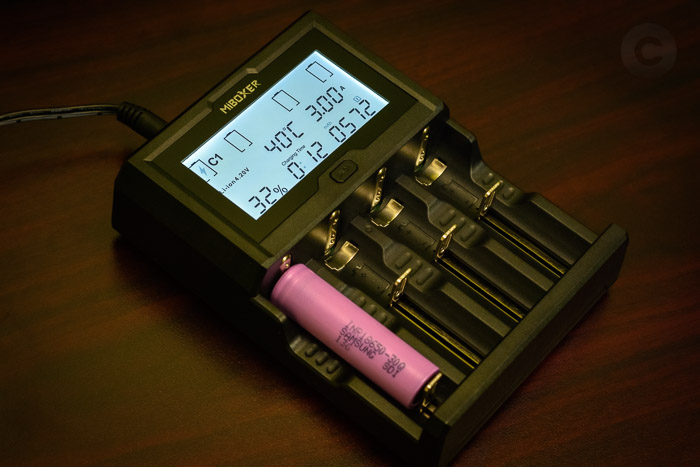
MANUFACTURER SPECS
Input voltage: DC 12V / 5A
Output voltage: 4.20V±1% / 1.48V±1%
Output current: Li-ion maximum 4*3A
Ni-MH/Ni-Cd maximum 4*1A
USB Output: DC 5V / 1A
Product weight: 305g
Supported cells:
Li-ion (4.2V) (IMR/INR/ICR):
10340 / 10350 / 10440 / 10500 / 12340 / 12500
12650 / 13450 / 13500 / 13650 / 14350 / 14430
14500 / 14650 / 16500 / 16340(RCR123) / 16650
17350 / 17500 / 17650 / 17670 / 18350 / 18490
18500 / 18650 / 18700 / 20700 / 21700 / 22500
22650 / 25500 / 26500 / 26650
Ni-MH / Ni-Cd (1.48V):
AAAA / AAA / AA / A / SC / C / D
CONSTRUCTION
Overall build quality seems very good and sturdy. The charger is on the larger size (see comparison photo against my Lii-500), but that has its benefits - more space between channels.
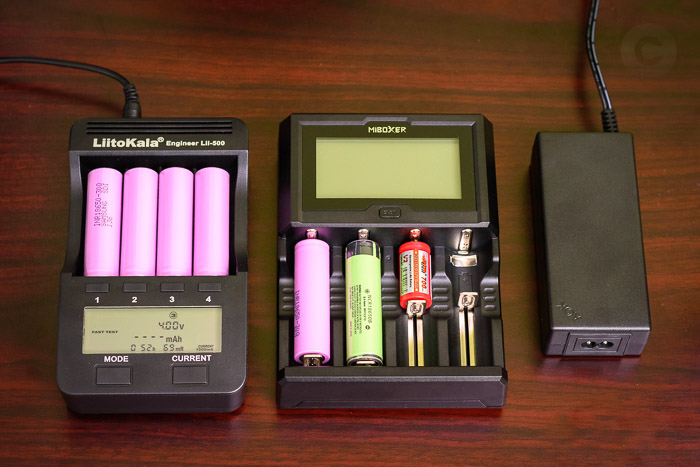
Single button is used to cycle between channels and select charging rate:
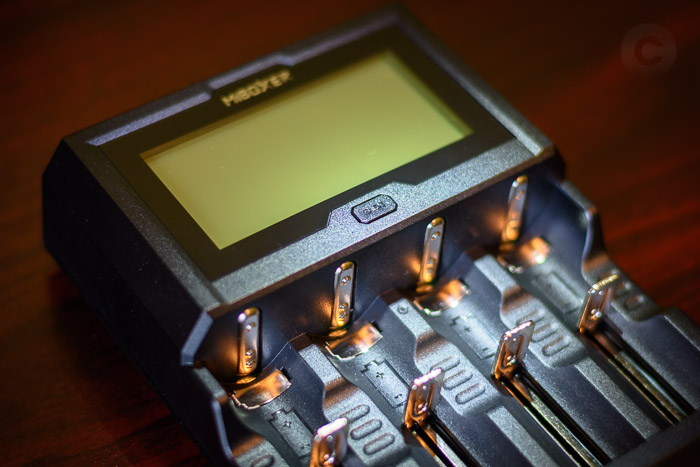
Rear panel:
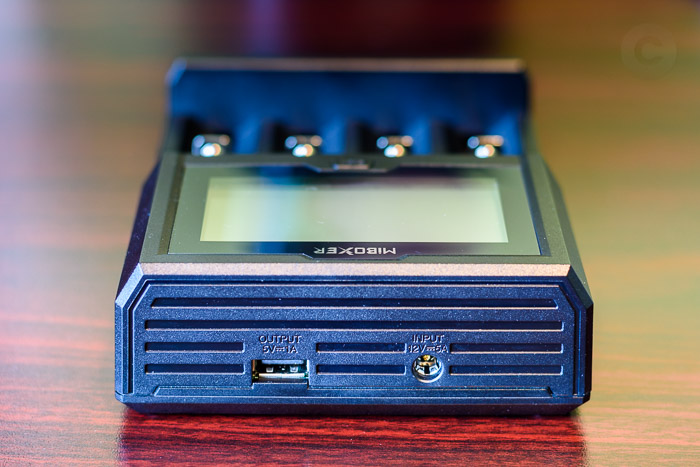
Back side markings:

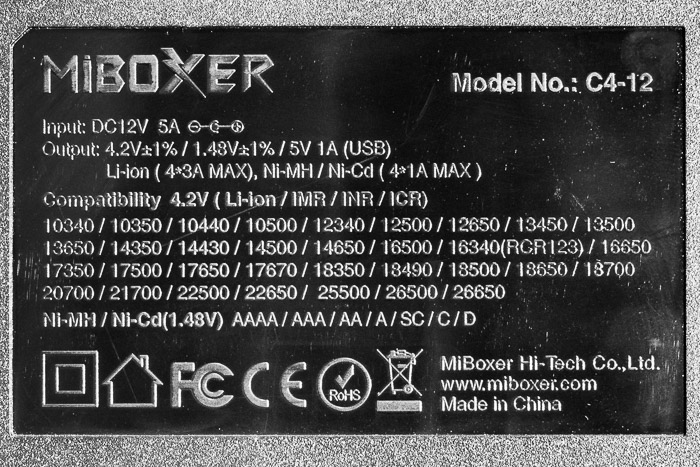
C4-12 uses an external power supply with a rated output of 12V, 5A. The PS gets warm, but not hot, during high rate charging.
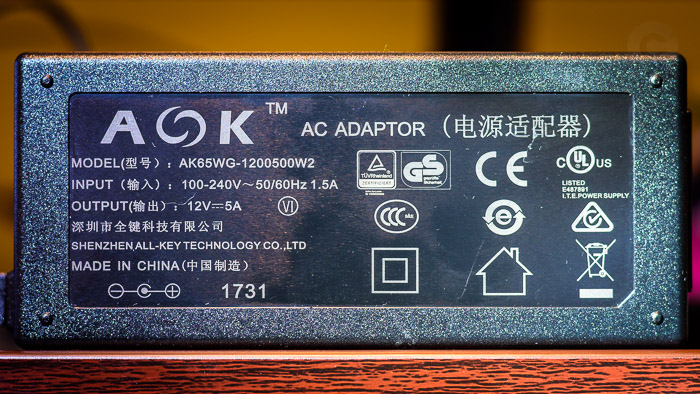
SLOTS/SLIDERS
Metal sliders appear robust, smooth sliding with good amount of clamping force. Nice spacing between channels makes removal of 18650 cells easy.


DISPLAY

The following information can be seen on the display:
• Chemistry
• Temperature
• % charge
• Charging time
• Charged capacity (mAh)
• Current (A) – based on some checking with my DMM, the charger shows actual current being delivered and not just the pre-selected current rate. The readings are very close to what I measured with a DMM.
• Voltage (V) – seems very accurate for Li-Ion cells, but about 0.04V low for NiMH cells.
• Internal Resistance (mOhm) –See below table for various results I got with different cells and different slots. I tested each slot 5 times with the same cell. The results are for fully charged cells. For depleted or partially depleted cells, the IR results are even more inconsistent. Consistency seems to vary depending on cell type. It is actually pretty good on some, and not good on others, and this impacts auto charge rate selection, as I noted further down.
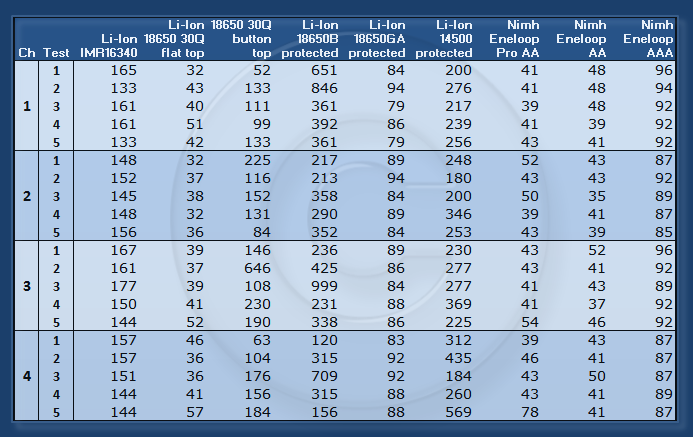
Current, Voltage, and IR occupy the same space on the display. The respective values cycle every couple of seconds…

CHARGING
Charger has two charging modes: Auto and Manual. When charging is complete, the display will indicate “100%” and “FULL” will flash in the mAh area.
Li-Ion cells read 4.18V on my DMM after end of charge. However, if you keep cells in the charger (still powered on) for hours after they’ve reached “FULL”, their voltage will continue to drop a bit. For example, a 16340 cell was down to 4.14V after a couple of hours of sitting in the charger. An 18650 cell was down to 4.15V after about 5 hours of sitting in the charger. So, my advice would be to remove the cells from the charger soon after they reach “FULL.”
AUTO
By default, if you insert a cell, the charger will automatically select the charging rate based on cell chemistry and IR (and possibly other parameters, not sure).
Now here is where things get a bit inconsistent… Auto charge rate selection is somewhat unpredictable on some cells. It is based on internal resistance (at least in large part), and since the IR readings are sometimes inconsistent, then so are the resulting charge currents.
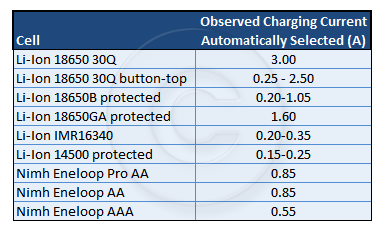
Based on what I’ve observed during my limited time with this charger, the charge rate is never unsafely high, but in some cases it’s lower than what I’d consider “normal” or “typical” and will result in very long charge times. Take a protected NCR18650B cell, for example. At one time, the charger measure its IR to be 105 mOhm, and applied 0.95A charge rate. That’s great. But next time I inserted that same cell, it measured its IR to be 182 mOhm, and applied 0.35A charge rate only. Again, perfectly safe, you’d just have to wait a lot longer to fully charge a 3400 mAh cell at this rate. Another time, same cell, it actually detected the IR to be 548 mOhm and applied 0.15A charge rate. If Miboxer could improve IR detection accuracy, then this whole auto charging current logic would work quite well and be more predictable, in my opinion.
However, a smart thing that Miboxer implemented in this C4-12 is that the charger will continue to measure IR throughout the charge cycle, and if it sees a drop in IR, it’ll increase charging rate accordingly. For example, when I inserted another NCR18650B cell, it charged it at 0.25A for the first hour or so, and then increased the rate to 1.05A based on an updated IR value that it obtained.
At any time during charging, you can always manually override the auto rate and choose one manually…
MANUAL:
Charge current rates available for NiMH cells:
0.1 / 0.2 / 0.3 / 0.4 / 0.5 / 0.6 / 0.7 / 0.8 / 0.9 / 1.0 A
Charge current rates available for Li-Ion cells:
0.1 / 0.2 / 0.3 / 0.5 / 0.8 / 1.0 / 1.5 / 2.0 / 2.5 / 3.0 A
Current selection is fairly straightforward: select the channel, and then long press the SLOT button to enter rate selection mode – current value will start blinking. Keep pressing the SLOT button until you reach the desired rate. After a couple of seconds, the rate will be accepted and the current value will stop blinking.
Charging Li-Ion at 3A
Below is a quick and dirty graph of charging current when charging a single Samsung INR18650-30Q flat top using a manually selected 3A rate. Sorry, I don’t have a way to log both current and voltage at the same time, which would have been more meaningful. I monitored voltage manually – it never exceeded 4.20V. Once removed from the charger, the cell was at 4.18V.
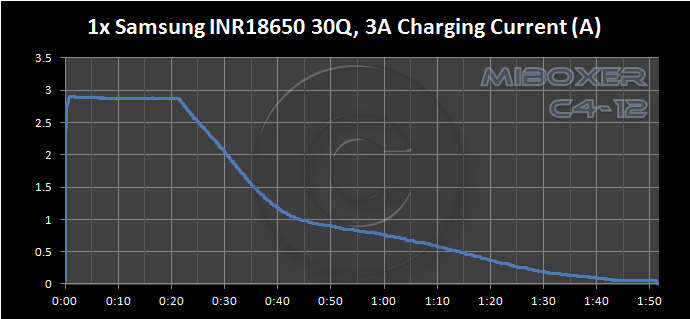
The charger starts ramping down current fairly early; however, this is most likely because of higher IR being detected as a result of my DMM being plugged into the circuit. You’ll have to wait for someone with better testing equipment to produce a proper curve. ![]() Termination current is about 0.05A.
Termination current is about 0.05A.
Charging Li-Ion at 4x2A
Here is a graph of charging current when charging a Samsung INR18650-30Q button top using a manually selected 2A rate. All four channels were being charged at 2A while data was being logged on Channel 1. Once removed from the charger, the cell was at 4.18V.
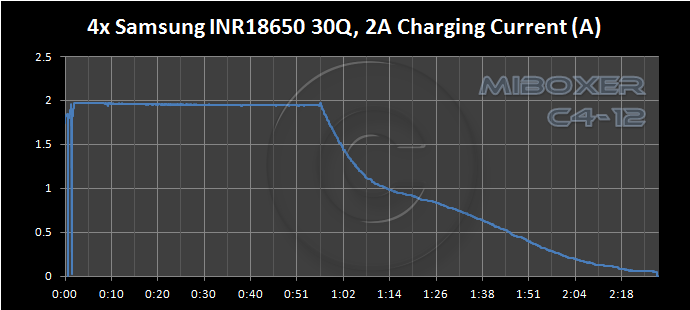
Charging Li-Ion at 4x3A
Here is a graph of charging current when charging a Samsung INR18650-30Q button top using a manually selected 3A rate. All four channels were being charged at 3A while data was being logged on Channel 1. As can be seen, my unit is not capable of sustaining 4x3A charge throughout the whole cycle. It will reboot after some time and will restart using lower charging rates. Once finished, when removed from the charger, cell voltage was 4.18V.
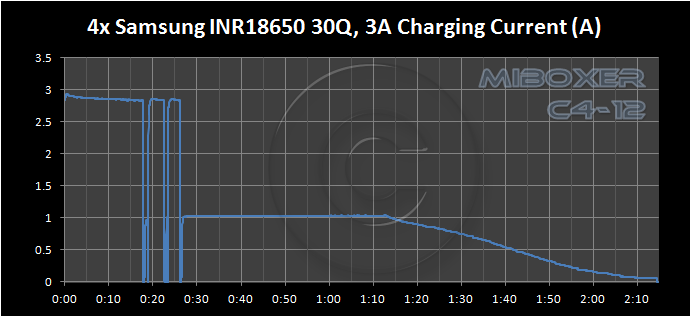
You can see dips in the graph when the reboot happened. First reboot happened after about 19 minutes. After it came back online, I again manually selected 3A for all channels, and as you see a few minutes later it rebooted again, and again. At that point I just let it continue in automatic fashion to the end.
The temp on the display was 52C when it rebooted. Yet, the owner’s manual states this:
So obviously, my experience is inconsistent with what’s described in the owner’s manual. However, what I have is a first version of this charger and Miboxer told me they tweaked it since and that in the newest version, the charger will better control temperature and will not reboot. My guess is, they’re going to throttle down charging current before the temps get too high.
So, what does this mean at the end of the day? It means that it’s a 4x3A charger, but not 100% of the time. When the temps rise, and rise they will, current rates will be reduced. I suspect adding an external fan might be a possible solution here, if you want to maintain 4x3A output longer. If I owned a fan, I would have tested it out. ![]()
I have not tested 4x2.5A charging yet.
Charging NiMH at 4x1A
Below is graph of charging current when charging an Eneloop Pro AA cell using a manually selected 1A rate (last 90 minutes or so). All four channels were being charged at 1A while data was being logged on Channel 1. Once removed from the charger, cell voltage was 1.48V. Max temperature observed during the charge cycle was 40 deg C.

USB OUTPUT
When charging my Nexus phone, the C4-12 indicated max charging current of 1.03A going out of the USB port. Sorry, I don’t have an easy way to verify its accuracy. I could only verify that 1.5A was being drawn from the cell at the time.
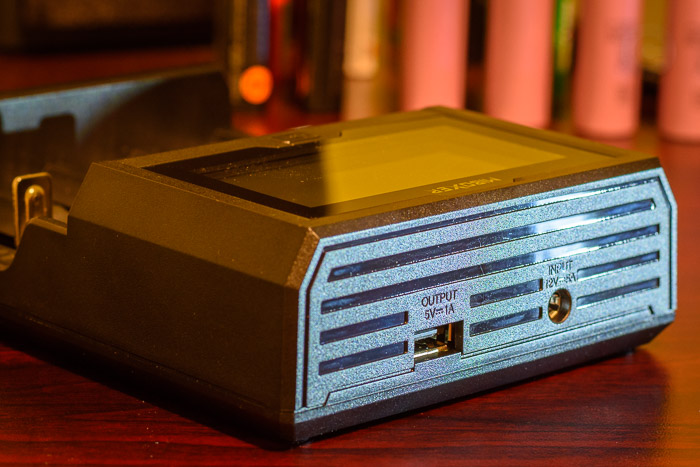
SUMMARY
Overall, I do like the charger. It is well made and it can fill Li-Ion cells notably quicker than my Lii-500, which is the primary reason why I’d own one. Personally, I wouldn’t want to rely on this charger to choose charge rate for me. I’d prefer to set it manually, and the charger gives me lots of options here. But for someone who just wants to pop cells in and not mess with any settings, the auto rate selection should work OK for the most part.
WHAT I LIKED:
#1. Well constructed
#2. Good spacing between channels makes removal of 18650 cells easy
#3. Good display – lots of info provided
#4. Relatively fast charging: 4x2A+ non-stop and partial 4x3A (up to about 50% of the way)
WHAT NEEDS IMPROVEMENT:
#1. Needs better charging logic to automatically ramp down current in order to not let temperature get too high and avoid a reboot. According to Miboxer, this has already been addressed in the newest version of this charger. Alternatively, a fan could be added, but I think the whole point of this charger was to avoid having one because a fan comes with its own set of problems.
#2. Improve IR accuracy – this would help make auto current rate selection more consistent for some cells.
DISCLAIMER: Item was provided by the manufacturer for evaluation.
